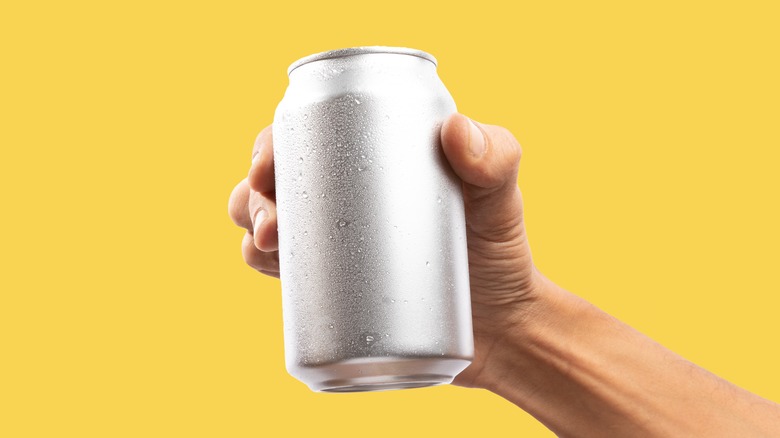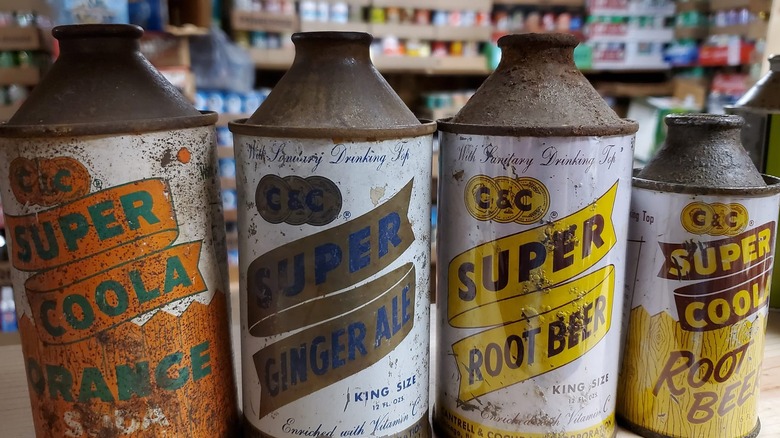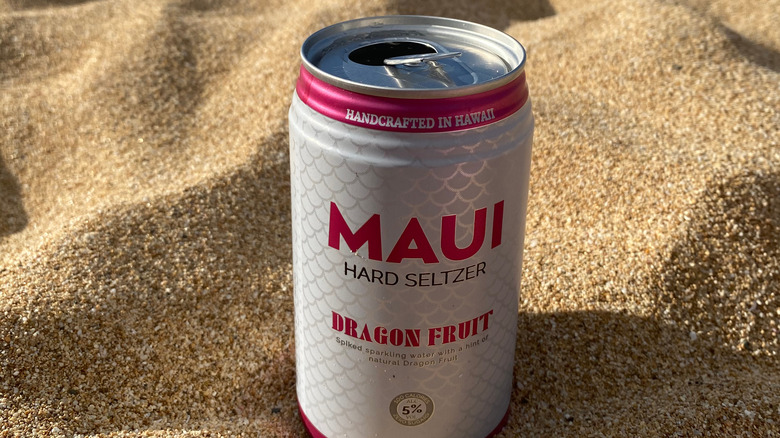The Reason Canned Soda Is Beveled On The Bottom
Soft drinks have been enjoyed for hundreds of years, starting in the 17th century when Europeans tried to mimic the therapeutic values of effervescent spring water. Since then, sodas have morphed in new ways, such as the 23 flavors that combine in Dr Pepper and Coca-Cola's new spiced flavor — not to mention now coming in plastic bottles and aluminum cans. Both beverage containers have changed significantly over time, but did you know that the modern can was designed for several helpful tricks?
If you take a look at the bottom of canned soda, you'll see a beveled edge that serves multiple purposes. Similar to other canned goods, the underside allows you to stack each can on top of one another so that more will fit into your refrigerator or pantry. This feature also allows stores to save space by stacking loose cans or six-packs.
You can even use the bottom bevel of one can to pull open the tab on another. Simply put one can on top of the other, and pull the top can forward so that the bevel grabs the tab of the bottom can, then use pressure to and momentum to open. This hack really comes in handy if you're injured or maybe just came from the nail salon.
Additionally, the foot of the can is concave, allowing it to withstand more pressure than a flat bottom could. In fact, soda cans are able to hold up to 90 pounds of liquid pressure per square inch, even though the aluminum is about 75 microns thick (via YouTube).
Soda cans have undergone many manufacturing changes
Soft drinks originated out of experiments to create carbonated, imitation mineral water, which was sold in bottles in the late 1700s. Eventually, ginger, lemon, and other flavors were added to the drinks in the mid-1800s. It was almost the mid-20th century, though, before cone-shaped steel cans were invented in the U.K. and used for beer and soft drinks — such as the original, Coca-Cola, invented in 1886. These rudimentary can designs had four height profiles with crown-cork seals.
In the United States, flat-top cans were an enhanced design that came about in the 1930s but required a special piece of pointed metal to open. Manufacturers continued to investigate better designs and developed aluminum cans with easy-open ends, or pull-ring levers, in the 1960s; ridges were also added for additional support. The convenience had a huge impact on beer and soda pop sales, with cans dominating the drinks market in the 1980s.
With canned soda's continued popularity, the cylindrical shape has remained largely the same since the '80s, but the circumference of the ends has been reduced multiple times over the years to save on the usage of metal, which has made modern soft drink cans slimmer compared to older designs. To make this possible, manufacturers altered the neck and foot shape, as well as the size of the spout, which is in the cans we see today. Other reasons why cans continue to get smaller are to save shelving space and attract more discerning shoppers.
There are different can designs around the world
Depending on where you drink your soda, the shape of the can may appear different. If you live in or visit Hawaii, you'll notice that some of the soft drink containers look different, featuring four ridges around the neck. This design is the work of the Kapolei, Oahu, can-making plant, which produces about 1 million cans per day for beer, juice, and soda on the island (via Star-Bulletin).
The facility still uses equipment from before the 1980s that creates the ridges and a slightly wider body compared to the equipment that mainland U.S. facilities use, the latter of which creates a smooth neck. The extra cost of producing this older design in Hawaii is offset by transport cost savings since the products are sold within the state. Because of that, you can find millions of Coca-Cola, Pepsi, and Tropicana canned drinks with ridges in island stores.
In other parts of the world, the smooth cylindrical shape of cans remains unchanged, but manufacturers are making them slimmer. The skinny design of Red Bull drinks, for example, has become more common as a standard for soft drinks in Europe and Russia, appealing to a younger demographic for its sleek style and ease of consuming the drink on the move. In Turkey, canned sodas are even smaller, rising in popularity and becoming an attractive option for nutrition-conscious consumers.



